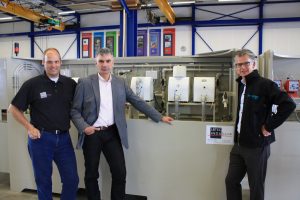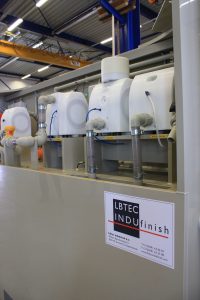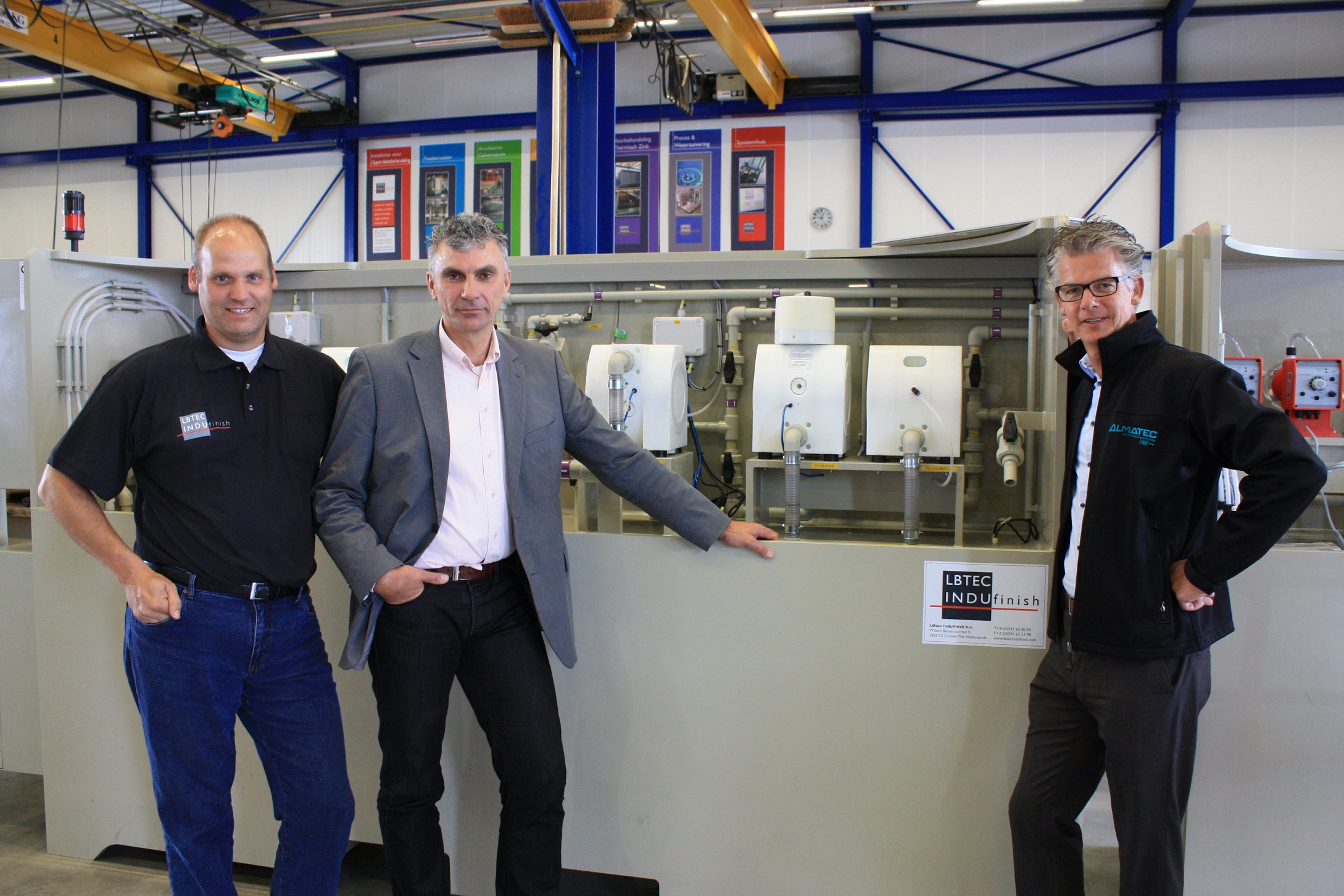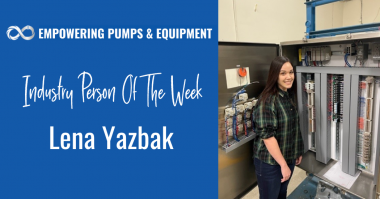Most people are aware that steel possesses the strength and structural reliability to support a 100-story skyscraper or a mile-long extension bridge. What they may be unaware of, though, is the fact that despite its overall robustness and strength, the process that is used to manufacture steel can be an extremely delicate one.
 One person who is intimately familiar with the intricacies of the steel-making process is Wim Brandsema. Brandsema is Director and 50% owner of LBTEC INDUfinish, Emmen, The Netherlands. Founded in 1991, LBTEC INDUfinish specializes in creating and supplying complete systems that are used in surface-treating steel, particularly pre-treatment applications in the hot-dip galvanizing process. The company uses 3-D computer-modeling technology to create complete systems that specifically follow the direction of the client for design and operation.
One person who is intimately familiar with the intricacies of the steel-making process is Wim Brandsema. Brandsema is Director and 50% owner of LBTEC INDUfinish, Emmen, The Netherlands. Founded in 1991, LBTEC INDUfinish specializes in creating and supplying complete systems that are used in surface-treating steel, particularly pre-treatment applications in the hot-dip galvanizing process. The company uses 3-D computer-modeling technology to create complete systems that specifically follow the direction of the client for design and operation.
“We are currently selling our equipment mainly throughout Europe and we are starting to pick up business in Northern Africa and the Middle East. We would also like to grow our business in South and North America,” said Brandsema. “LBTEC INDUfinish is very specialized in hot-dip galvanizing, particularly the pre-treatment stage of the hot-dip galvanizing process.”
Hot To Trot
The pre-treatment stage that leads to the actual hot-dip galvanizing of steel is a very precise and exacting one:
- A piece of raw steel is pre-treated with a degreaser to remove any oil and grease from its surface
- Then the steel is “pickled” in a hydrochloric acid bath
- After pickling, the steel is dipped in flux fluid; the flux fluid ensures that the zinc will react correctly with the steel
- The steel is then placed in a melted zinc bath with a temperature of 450ºC (842ºF); if the previous three steps are not followed properly, the zinc will not adhere to the raw steel, resulting in a substandard product
- After receiving its hot-zinc bath, the piece of steel is hot-dip galvanized
What LBTEC INDUfinish has done is create a system that houses the flux fluid that is used in the pre-treatment process. The system consists of four compartments: the first contains the flux fluid; the second mixes the flux fluid with certain chemicals to obtain the correct pH level; the third receives the flux fluid after it has passed through a filter press that makes sure that any iron in the flux fluid is collected so that only clean flux fluid comes out; and the fourth gathers the used flux fluid before it is transferred to the flux-cleaning unit and back to the first flux-fluid tank. The heartbeat of the system is the four individual pumps that keep the flux fluid flowing flawlessly between the four compartments.
“We began producing these units in 2006 and the most important issue is that you have to make sure it is not going to be corroded when operated,” said Brandsema. “Flux fluid is very aggressive so we have to have a pump that that will last at least 10 years. We knew that to manufacture our products we would need plastic pumps that would have to deal with very corrosive fluids like hydrochloric acid. Steel, carbon steel and stainless steel aren’t compatible with these very aggressive fluids, so you need plastics like PE, PP, PVCs and PVDF.”
The Perfect Pump For The Process
When LBTEC INDUfinish began creating its flux-fluid systems it was searching for the perfect pump to control the process. Too often, the technology that was chosen for the second stage of the process—where the chemical solution was being introduced to the flux fluid for pH control—was falling short in its ability to meet the system’s needs.
 “When we first built this system in 2006, we started off with an electric-driven, vertical centrifugal pump for the second stage, but it lasted only six months,” said Erik van der Staaij, Sales Manager for LBTEC INDUfinish. “At that point, the engine was rotted away by the chemistry we were pumping, so we needed a very corrosion-resistant solution.”
“When we first built this system in 2006, we started off with an electric-driven, vertical centrifugal pump for the second stage, but it lasted only six months,” said Erik van der Staaij, Sales Manager for LBTEC INDUfinish. “At that point, the engine was rotted away by the chemistry we were pumping, so we needed a very corrosion-resistant solution.”
In the search for a solution, LBTEC INDUfinish had to look no further than the other three pumps that were contained in the system, which were all E-Series Solid-Body Plastic Air-Operated Double-Diaphragm (AODD) Pumps from Almatec®, Kamp-Lintfort, Germany. Almatec is a leading brand of AODD pumps from PSG®, a Dover company, Oakbrook Terrace, IL, USA.
“We looked at the other three pumps that were mounted on the system at the time and they were Almatec pumps,” said van der Staaij. “We didn’t see any corrosion on those pumps, so we mounted another Almatec pump for the process of mixing up the chemical solution and it worked fine. We have never seen any leakage from the pump or connections, not on the thread or the pump body itself; everything sits tight.”
To ensure that it had a ready supply of Almatec pumps on hand, and that its growing customer base would have instant access to any replacement pumps or parts that were necessary, LBTEC INDUfinish turned to its supplier, Holland Air Pumps of Oirschot, The Netherlands, which is an exclusive distributor of Almatec pumps.
“We always try to help out our customers with the best service,” said Gerrit Klaassen, Commercial Director for Holland Air Pumps. “We knew what the solution was for them. It has been the Almatec pump. Looking at this installation, it’s used in dangerous situations pumping dangerous chemicals and you really need a reliable pump and reliable system. They needed a pump that cannot corrode and was always tight, never leaks, so we put in an Almatec and they were very happy with it, and most important, the end-user is very sure they have a safe solution.”
 Almatec’s solid-body plastic AODD pumps have many features that set them apart from the competition when the subject is the handling of corrosive fluids. Plastic AODD pumps are positive displacement pumps that have a diaphragm in each of their two pumping chambers. These diaphragms are connected by a shaft so that when the compression stroke takes place in one chamber during the pumping process, the suction stroke takes place simultaneously in the other chamber. This results in efficient, reliable, cost-effective, repeatable operation when handling any type of corrosive liquid.
Almatec’s solid-body plastic AODD pumps have many features that set them apart from the competition when the subject is the handling of corrosive fluids. Plastic AODD pumps are positive displacement pumps that have a diaphragm in each of their two pumping chambers. These diaphragms are connected by a shaft so that when the compression stroke takes place in one chamber during the pumping process, the suction stroke takes place simultaneously in the other chamber. This results in efficient, reliable, cost-effective, repeatable operation when handling any type of corrosive liquid.
All E-Series pumps feature a solid-body design and most are constructed of polyethylene (PE), which offers excellent abrasion-resistance. The E-Series pumps, thanks to their PE construction, have abrasion-resistance that is seven times higher than pumps that are made with polypropylene (PP) – while still having similar chemical-resistance characteristics – and are 1.6 times more durable than stainless-steel pumps.
Solid PE also delivers better sealing, higher static weight, smoother operation and better torque retention than other popular materials of construction. For specific applications, E-Series pumps can also be constructed of PE, PE conductive, PTFE and PTFE conductive. All of the pump’s cylinder valves are constructed with PTFE with the diaphragms (EPDM, PTFE/EPDM and NBR) and ball valves (EPDM, PTFE, NBR and stainless steel) available in a range of materials.
Every housing part on an E-Series pump is tightened to each other via housing bolts. However, instead of single bolts that press punctually against the housing, all of the bolts are tightened against a diaphragm-sized ring on each side of the pump. This results in a more even spreading of the housing-bolt force and an increase in permissible bolt torque, which enhances safety and reliability. An optimized flow pattern reduces the pump’s flow resistance, which results in increased efficiency and lower air consumption.
Other standout features found in E-Series pumps include:
- The patented maintenance- and lubrication-free PERSWING P® air-control system, which ensures accurate reversal of the main piston
- Optimized flow path for increased energy efficiency
- Internal Piston Diaphragm (IPD) technology
- Integral dampeners for constant flow with no need for additional piping
- ATEX conformity for PE conductive and PTFE conductive models
- Variable port configurations
- No drives, rotating parts or shaft seals
- Easy startup
- Metal-free exterior
- Options include: barrier-chamber system for leak prevention; screw-on or flanged pulsation dampener; back-flushing system; stroke counter; diaphragm-monitoring system; and transport cart
Almatec offers its E-Series pumps in seven sizes, from 1/4″ to 3″, with flow rates ranging from 15 to 800 L/min (4 to 210 gpm).
Conclusion
Steel may be strong, but its final strength is only derived from the strength of the weakest link in its production chain. Realizing the importance of pre-treatment of steel in the hot-galvanizing process, LBTEC INDUfinish set out to create a system that its end-user customers could rely on intimately to perform perfectly each and every time. That search for perfection brought the company to Almatec and its E-Series Plastic Solid-Body AODD Pumps. Since 2006, it has been a marriage made in heaven as LBTEC INDUfinish has produced more than 50 flux-fluid systems that are used in steel-making applications around the world, all of which feature Almatec E-Series pumps.
“The first Almatec pump from 2006 we overhauled in 2012 and we changed the membranes, we changed the vales, we changed everything, but there was no need to change them,” marveled Brandsema. “It was still running perfectly with the valves and membranes of 2006, even handling an aggressive fluid. At the heart of each of our units you will find Almatec E-Series plastic pumps. We rely on them, and we would choose nothing else.”
About the author:
Bernd Reitemeyer is the Regional Manager – Western Europe for Almatec® and PSG®. He can be reached at Bernd.Reitemeyer@psgdover.com. Almatec is a leading brand of air-operated double-diaphragm (AODD) pumps from PSG®, a Dover Company. Headquartered in Oakbrook Terrace, IL, USA, PSG is comprised of several of the world’s leading pump brands, including Abaque®, Almatec®, Blackmer®, Ebsray®, Griswold™, Neptune™, Maag Industrial Pumps, Mouvex®, Quattroflow™, RedScrew™ and Wilden®. For more information on Almatec or PSG, please go to www.almatec.de or www.psgdover.com.





Comments